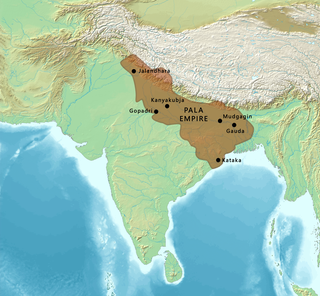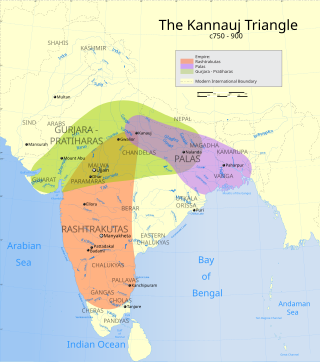
The middle kingdoms of India were the political entities in the Indian subcontinent from 230 BCE to 1206 CE. The period begins after the decline of the Maurya Empire and the corresponding rise of the Satavahana dynasty, starting with Simuka, from 230 BCE. The "middle" period lasted for almost 1436 years and ended in 1206 CE, with the rise of the Delhi Sultanate, founded in 1206, and the end of the Later Cholas.

Magadha also called the Kingdom of Magadha or the Magadha Empire, was a kingdom and empire, and one of the sixteen Mahajanapadas, 'Great Kingdoms' of the Second Urbanization, based in southern Bihar in the eastern Ganges Plain, in Ancient India. Magadha was ruled by the Brihadratha dynasty, the Haryanka dynasty, the Shaishunaga dynasty, the Nanda dynasty, the Mauryan dynasty, the Shunga dynasty and the Kanva dynasty. It lost much of it territories after being defeated by the Satavahanas of Deccan in 28 BC and was reduced to a small principality around Pataliputra. Under the Mauryas, Magadha became a pan-Indian empire, covering large swaths of the Indian subcontinent and Afghanistan.

Kannauj is a city, administrative headquarters and a municipal board or Nagar Palika Parishad in Kannauj district in the Indian state of Uttar Pradesh. The city's name is an evolved form of the classical name Kanyakubja. It was also known as Mahodaya during the time of Mihira Bhoja. It is situated 104 kilometres west of the state capital, Lucknow.

The Gurjara-Pratihara was a dynasty that ruled much of Northern India from the mid-8th to the 11th century. They ruled first at Ujjain and later at Kannauj.

The Pāla Empire was an imperial power during the post-classical period in the Indian subcontinent, which originated in the region of Bengal. It is named after its ruling dynasty, whose rulers bore names ending with the suffix Pāla. The empire was founded with the election of Gopāla as the emperor of Gauda in late eighth century CE. The Pala stronghold was located in Bengal and eastern Bihar, which included the major cities of Gauḍa, Vikramapura, Pāṭaliputra, Monghyr, Somapura, Ramavati (Varendra), Tāmralipta and Jaggadala.

Kamarupa, an early state during the Classical period on the Indian subcontinent, was the first historical kingdom of Assam.

The Pala dynasty of Kamarupa kingdom ruled from 900 CE. Like the Pala Empire of Bengal, the first ruler in this dynasty was elected, which probably explains the name of this dynasty "Pala". But unlike the Palas of Bengal, who were Buddhists, the Palas of Kamarupa were Hindus. The Hindu orthodoxy drew their lineage from the earlier Varman dynasty and thus ultimately from Narakasura i.e. Bhauma dynasty. The dynasty is unrelated to the previous Varman and Mlecchna dynasties.

The Vishnukundina dynasty was an Indian dynasty based in Deccan, which ruled territory comprising present-day Andhra Pradesh, Telangana, Odisha and other parts of southern India during the 5th and 7th centuries, carving land out from the Vakataka Empire. It played an important role in the history of the Deccan during the 5th and 7th centuries. The dynasty initially ruled from Indrapalanagara, and later shifted to Denduluru, and Amaravathi.

The Kamboja-Pala dynasty ruled parts of Bengal in the 10th to 11th centuries CE, after invading the Palas during the reign of Gopala II. The last Kamboja ruler of the Kamboja-Pala Dynasty Dharmapala was defeated by the south Indian Emperor Rajendra Chola I of the Chola dynasty in the 11th century.

Bikrampur was a pargana situated 19 kilometres (12 mi) south of Dhaka, the modern capital city of Bangladesh. In the present day, it is known as the Munshiganj District of Bangladesh. It is a historic region in Bengal and was a part of the Bhawal Estate.

Pataliputra, adjacent to modern-day Patna, was a city in ancient India, originally built by Magadha ruler Ajatashatru in 490 BCE, as a small fort near the Ganges river. Udayin laid the foundation of the city of Pataliputra at the confluence of two rivers, the Son and the Ganges. He shifted his capital from Rajgriha to Pataliputra due to the latter's central location in the empire.

North Guwahati is a Northern part of Guwahati city. And serves headquarters of Kamrup rural district in the Indian state of Assam. This place abounds in historical places and picnic spots. The place is famous for Doul Govinda Temple. North Guwahati Ancient name is Durjaya.
Velanati Chodas or Velanati Durjayas were a dynasty who ruled over parts of the Andhra Pradesh in the 12th century. They were Vassals of Later Cholas and Western Chalukyas and ruled over the region of Kammanadu in modern Guntur district.

The Tripartite Struggle, also known as The Kannauj Triangle Wars, for control of northern India took place in the ninth century, among the Gurjara-Pratihara Empire, the Pala Empire and the Rashtrakuta Empire.
Chandradwip or Chandradvipa is a small region in Barisal District, Bangladesh. It was the ancient and medieval name of Barishal.

Ratna Pala was the son of Brahma Pala in Pala Dynasty (900–1100) of Kamarupa Kingdom. His queen's name was Durlabha. He was succeeded by Indra Pala.

Dharma Pala (1035–1060) was ruler of Pala Dynasty (900–1100) of Kamarupa Kingdom.

Kamarupa – Late to end period was a period of Kamarupa kingdom from founding of Pala Dynasty by Brahma Pala to last ruler of dynasty Jaya Pala.

Kamrup is the modern region situated between two rivers, the Manas and the Barnadi in Western Assam, with the same territorial extent as the Colonial and post-Colonial "Undivided Kamrup district". It was the capital region of two of the three dynasties of Kamarupa and Guwahati, the current political center of Assam, is situated here. It is characterized by its cultural artifacts.















